Analog 4-Voice Polyphonic Synthesizer with 37 Full-Size Keys, 4 VCOs, Classic Ladder Filter, LFO, BBD Stereo Chorus, Distortion, 32-Step Sequencer and Arpeggiator
-
Analog synthesizer with quadruple VCO design allows for insanely fat music creation
-
4-Voice polyphonic/paraphonic design with mono, unison and polyphonic mode
-
37 semi-weighted full-size keys featuring velocity functionality
-
Authentic reproduction of original D Type circuitry with matched transistors and JFETs
-
Ultra-high precision 0.1% Thin Film resistors and Polyphenyline Sulphide capacitors
-
Pure analog signal path based on authentic VCO, VCF and VCA designs
-
5 variable oscillator shapes with variable pulse widths for ultimate sounds
-
Classic 24 dB ladder filter with resonance for legendary sound performance
-
Amazing stereo chorus based on authentic circuitry
-
Distortion circuitry adds insane spice and edge to your sounds
-
Easy-to-use voltage controlled 32-step sequencer with 64 sequence locations
-
Arpeggiator with wide patterns for great sound effects
-
Switchable low/high pass filter mode for enhanced sound creation
-
Dedicated and fully analog triangle/square wave LFO
-
Noise generator dramatically expands waveform generation
-
84 controls give you direct and real-time access to all important parameters
-
External audio input for processing external sound sources
-
Stereo outputs featuring servo-balanced output stages for highest signal integrity
-
Comprehensive MIDI implementation with MIDI channel and Voice Priority selection
-
Designed and engineered in the U.K.
The 1970s spawned the first truly portable analog synthesizer, and while it was quickly adopted by lots of renowned musical artists including Jan Hammer, Chick Corea, Rick Wakeman, Jean-Michel Jarre, Isao Tomita and Keith Emerson to name a few, it was somewhat temperamental and very expensive. An ultra-affordable homage to that iconic synthesizer, with all the features of the original and then some, the Behringer POLY D lets you conjure up virtually any monophonic or polyphonic sound imaginable with incredible finesse and ease. The pure analog signal path is based on authentic VCO, VCF, VCA and ladder filter designs in conjunction with a dedicated and fully analog triangle/square wave LFO. Owning a POLY D is like having your own personal time machine, enabling you to freely embrace the past – or shape the future!

True to the Original
Great care has been taken in designing the POLY D including the true to the original “D Type” circuitry with its matched transistors and JFETs, ultra-high precision 0.1% thin film resistors and polyphenylene sulphide capacitors. This highly-focused attention to detail is what gives the POLY D its ultra-flexible sound shaping capability, which covers everything from super-fat bass and lead tones, stunning effects, progressive organ sounds – and all the way out to the otherworldly sounds of your imagination.

Big, Fat Tones
The inspired synthesizer tracks laid down in the 1970s and '80s are etched in the annals of progressive rock, wave and synth-pop music forever, making them truly classic in every sense of the word. POLY D’s pure analog signal path with legendary VCO, VCF and VCA circuits, lets you recreate all of that magic – or design incredibly fat and original sounds that will make you a legend in your own right!
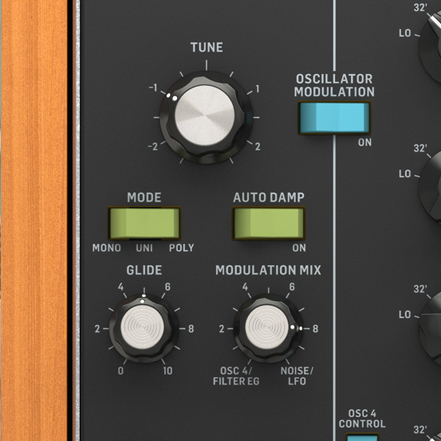
Three Modes to Choose From
With the POLY D, you can get the best of three worlds by switching between monophonic, polyphonic or unison modes. With the POLY D set to Mono, you can have the characteristics of a classic monophonic synth with fuller, more expressive solos, bass lines and portamentos. Flipping the switch to Poly allows you to play more than one note at the same time to produce stunning chord harmonies and luscious pads that add soul and depth to your music. Unison Mode thickens up your sound by layering all of the POLY D’s voices on top of each other, adding more harmonic content and creating a richer sound.
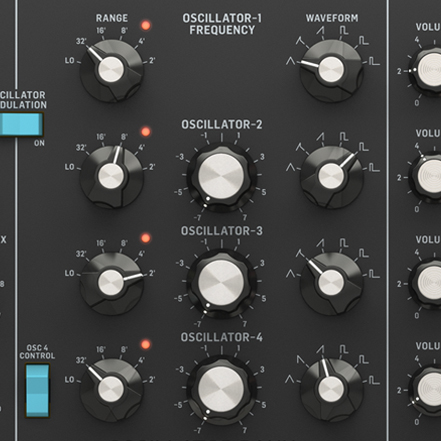
Four VCOs
The POLY D has four highly-flexible Voltage Controlled Oscillators (VCOs) that provide an incredible range of 5 waveforms for sculpting the perfect sound. Oscillators 1, 2 and 3 options include: triangular; triangular/saw; saw; square; wide pulse; and narrow pulse, while OSC 4 features: triangular; reverse saw; saw; square; wide pulse; and narrow pulse. Additionally, all 4 VCOs can be adjusted across an extremely-wide, 6-octave range (LO, 32’, 16’, 8’, 4’ and 2’). This amazing flexibility gives you all the tools you need to be your creative best.
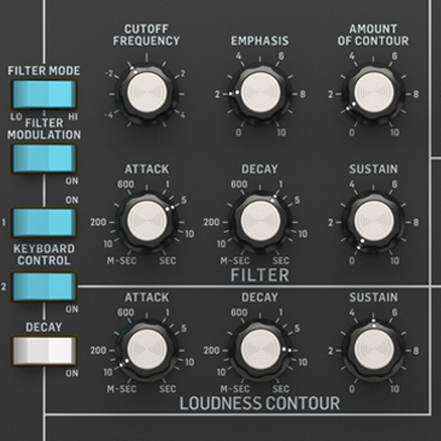
24 dB Ladder Filter and VCA
The very heart of the POLY D’s sound is its highly flexible 24 dB Ladder Filter, which lets you freely experiment with the Cutoff Frequency, Emphasis and Contour to dial in the perfect sound. POLY D’s Filter Mode switch can be set to either Lo- or Hi-pass for selecting the range of your choice. You can also adjust the Attack, Decay and Sustain controls to affect the cutoff frequency with time.
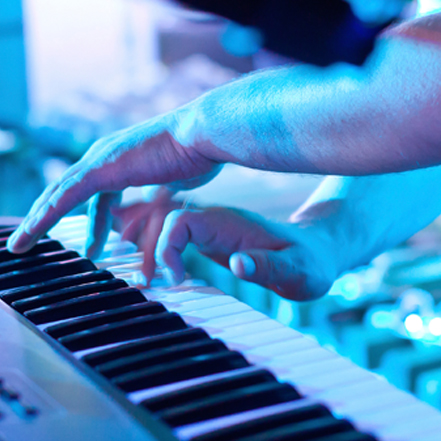
Controls & Connectivity
We just can’t help ourselves – like you, we're gear-heads, too. For those who want the numbers, POLY D has 84 controls, all laid out in a highly-intuitive format that puts the joy back into your music creation. Input and output connections include: MIDI I/O and Thru over USB/MIDI DIN; After Pressure and Velocity outputs with their own dedicated volume controls; internal and external V-Trig I/O; external Loudness, Filter, OSC, and modulation source outputs.
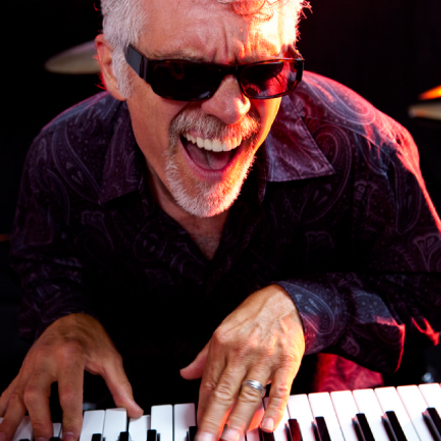
Unleash Your Imagination
When it comes to not just pushing envelopes but creating them, POLY D gives your imagination its voice – and it’s so very affordable. When modern performance calls for classic analog sound – it calls for the Behringer POLY D!
Visit your dealer to experience the stunning POLY D or get yours online today. Music never felt this good!
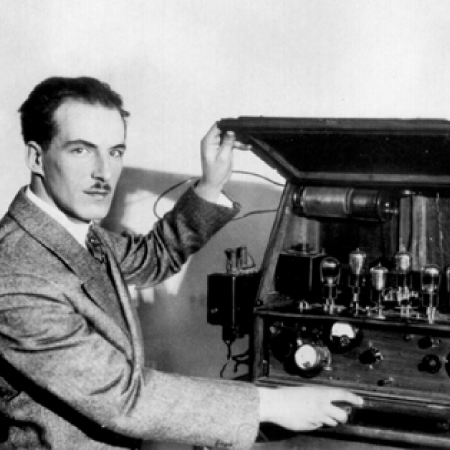
A Brief History of Analog Synthesis
The modern synthesizer’s evolution began in 1919, when a Russian physicist named Lev Termen (also known as Léon Theremin) invented one of the first electronic musical instruments – the Theremin. It was a simple oscillator that was played by moving the performer’s hand in the vicinity of the instrument’s antenna. An outstanding example of the Theremin’s use can be heard on the Beach Boys iconic smash hit “Good Vibrations”.
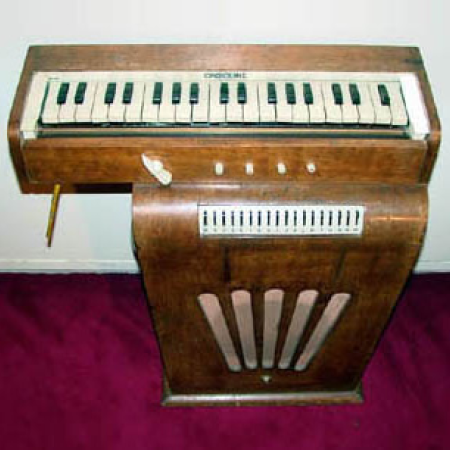
Ondioline
In the late 1930s, French musician Georges Jenny invented what he called the Ondioline, a monophonic electronic keyboard capable of generating a wide range of sounds. The keyboard even allowed the player to produce natural-sounding vibrato by depressing a key and using side-to-side finger movements. You can hear the Ondioline on Del Shannon’s “Runaway”.
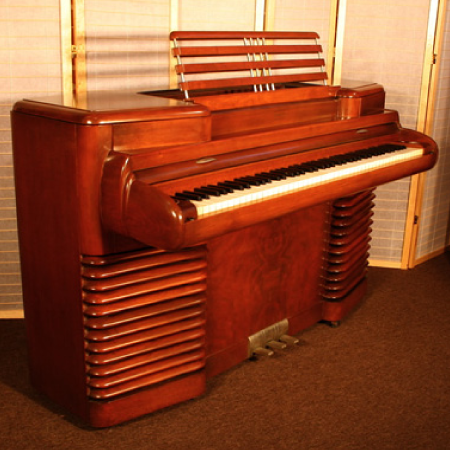
Storytone Piano
Designed by famous piano manufacturer Story & Clark in association with RCA, the Storytone piano debuted at the 1939 New York World’s Fair. Hailed as the world’s first electric piano, the Storytone is prized by musicians and collectors alike for its realistic piano sound – only 500 or so were ever built.
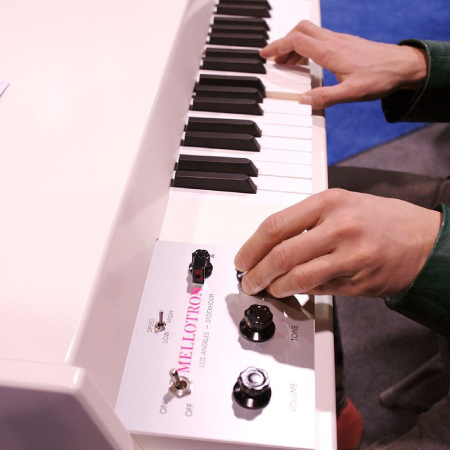
Mellotron
Finding a high level of acceptance in the 1960s, Harry Chamberlin’s Mellotron was an electro-mechanical keyboard that generated sounds by playing back pre-recorded tape loops. Although tempermental and prone to pitch and mechanical issues, the Mellotron was used extensively by many U.K. artists. Classic tracks from the Moody Blues “Days of Future Passed”, the Beatles “Strawberry Fields Forever”, and the Rolling Stones “She’s a Rainbow” are prime examples. Attribute author: By Buzz Andersen from San Francisco, California, United States Mellotron | NAMM 2007
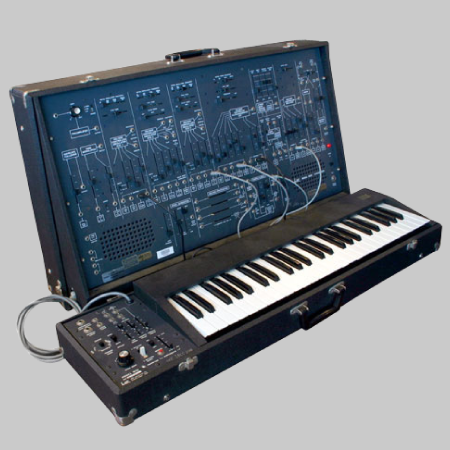
Arp 2600
Manufactured by ARP Instruments, Inc., the Arp 2600 was one of the most successful synthesizers to come out of the 1970s. They were ideal for players new to the synth world, and allowed patches to be changed via switches or 1/8" audio cables. The list of recordings and artists that used the venerable Arp 2600 reads like a veritable Who's Who of rock, pop and jazz, and includes The Who, David Bowie, John Lennon, Depeche Mode, Edgar Winter, Frank Zappa and Herbie Hancock – to name just a few. An Arp 2600 was even used to create the voice of the Star Wars character R2-D2. Attribute author: The original uploader was Kimi95 at Italian Wikipedia - http://www.vintagesynth.com/arp/arp2600blue.jpg e http://www.vintagesynth.com/arp/arp.php, CC BY 3.0, https://commons.wikimedia.org/w/index.php?curid=7708499
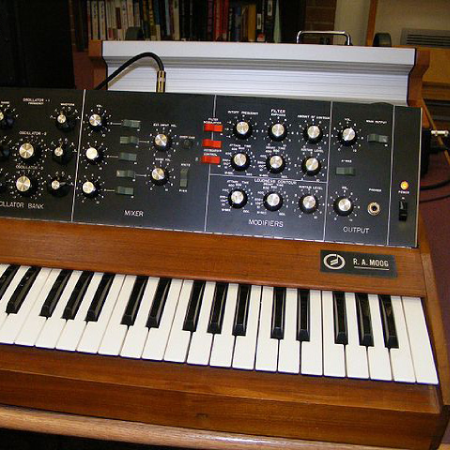
Minimoog
Designed to replace the large, modular synths being used in pop music at the time, Bill Hemsath and Robert Moog developed the Minimoog in 1971. The monophonic instrument became the first truly all-in-one, portable analog synthesizer. Thanks to its 3 oscillators and 24 dB/octave filter, the Minimoog produces an extremely rich and powerful bass sound and is still in high demand today. Yes keyboardist Rick Wakeman said the instrument “absolutely changed the face of music.” Attribute author: glacial23 - Early Minimoog Uploaded by clusternote, CC BY-SA 2.0
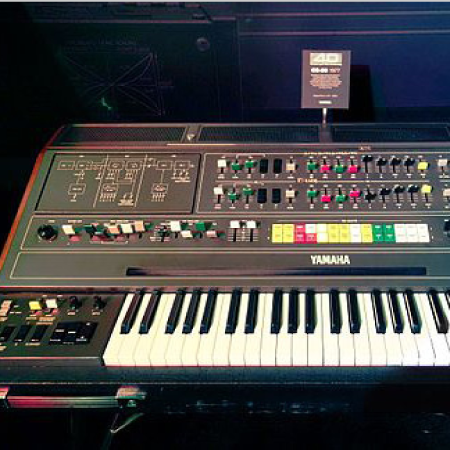
Yamaha CS-80
In 1976, Yamaha released their CS-80 8-voice polyphonic synthesizer, which provided velocity-sensitive keys and aftertouch that worked on individual voices. The analog instrument featured a ribbon controller, which allowed the user to perform polyphonic pitch bends and smooth glissandos. Composer Vangelis used the CS-80 extensively in the Blade Runner and Chariots of Fire soundtracks. The CS-80 also provided the bass line heard in the BBC 1980 series Doctor Who theme song. Image attribution: Pete Brown from Gambrills, MD, USA (DSC00539) [CC BY 2.0 (http://creativecommons.org/licenses/by/2.0)], via Wikimedia Commons
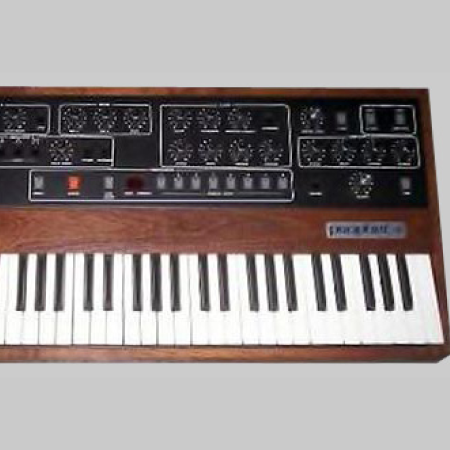
Sequential Circuits Prophet 5
Sequential Circuits introduced the Prophet 5, which was the first analog 5-voice polyphonic synthesizers to provide onboard memory storage of all patch settings for instant recall. The great-sounding Prophet 5 revolutionized the synthesizer world and, in spite of its rather expensive price tag, became one of the most successful synths of all time. Designed by Dave Smith and J owen, the Prophet 5 was the keyboard of choice by a very long list of performers that includes Peter Gabriel, Philip Glass, Journey, The Cars, Thomas Dolby, Duran Duran, Gary Numan, Pink Floyd, and countless others. Image attribution: original uploader was Felix2036 at Dutch Wikipedia derivative work: Clusternote (Sequential_Circuits_Prophet_5.jpg) [Public domain], via Wikimedia Commons Which brings us to 1977...

A Passion for Keyboards
Our founder, Uli Behringer has a deep passion for keyboards. Born in the small town of Baden, Switzerland in 1961, Uli grew up in a musical family where his mother taught him to play the piano at the tender age of four. His father was a scientist who built a massive organ in the family home and taught the young lad all about electronics. So, at the age of 17, Behringer built his first synthesizer – the UB-1. Later, while attending college to seek a degree in audio engineering, Uli put his electronics knowledge to use, building his own equalizers and signal processors to fill the gap left by the university's inability to provide enough proper studio gear. Word soon spread about how good his products were, and he began building gear for his friends – the Behringer legacy had begun. The rest, as they say, is history...
POLY D
Analog 4-Voice Polyphonic Synthesizer with 37 Full-Size Keys, 4 VCOs, Classic Ladder Filter, LFO, BBD Stereo Chorus, Distortion, 32-Step Sequencer and Arpeggiator
-
Analog synthesizer with quadruple VCO design allows for insanely fat music creation
-
4-Voice polyphonic/paraphonic design with mono, unison and polyphonic mode
-
37 semi-weighted full-size keys featuring velocity functionality
-
Authentic reproduction of original D Type circuitry with matched transistors and JFETs
-
Ultra-high precision 0.1% Thin Film resistors and Polyphenyline Sulphide capacitors
-
Pure analog signal path based on authentic VCO, VCF and VCA designs
-
5 variable oscillator shapes with variable pulse widths for ultimate sounds
-
Classic 24 dB ladder filter with resonance for legendary sound performance
-
Amazing stereo chorus based on authentic circuitry
-
Distortion circuitry adds insane spice and edge to your sounds
-
Easy-to-use voltage controlled 32-step sequencer with 64 sequence locations
-
Arpeggiator with wide patterns for great sound effects
-
Switchable low/high pass filter mode for enhanced sound creation
-
Dedicated and fully analog triangle/square wave LFO
-
Noise generator dramatically expands waveform generation
-
84 controls give you direct and real-time access to all important parameters
-
External audio input for processing external sound sources
-
Stereo outputs featuring servo-balanced output stages for highest signal integrity
-
Comprehensive MIDI implementation with MIDI channel and Voice Priority selection
-
Designed and engineered in the U.K.
The 1970s spawned the first truly portable analog synthesizer, and while it was quickly adopted by lots of renowned musical artists including Jan Hammer, Chick Corea, Rick Wakeman, Jean-Michel Jarre, Isao Tomita and Keith Emerson to name a few, it was somewhat temperamental and very expensive. An ultra-affordable homage to that iconic synthesizer, with all the features of the original and then some, the Behringer POLY D lets you conjure up virtually any monophonic or polyphonic sound imaginable with incredible finesse and ease. The pure analog signal path is based on authentic VCO, VCF, VCA and ladder filter designs in conjunction with a dedicated and fully analog triangle/square wave LFO. Owning a POLY D is like having your own personal time machine, enabling you to freely embrace the past – or shape the future!

True to the Original
Great care has been taken in designing the POLY D including the true to the original “D Type” circuitry with its matched transistors and JFETs, ultra-high precision 0.1% thin film resistors and polyphenylene sulphide capacitors. This highly-focused attention to detail is what gives the POLY D its ultra-flexible sound shaping capability, which covers everything from super-fat bass and lead tones, stunning effects, progressive organ sounds – and all the way out to the otherworldly sounds of your imagination.

Big, Fat Tones
The inspired synthesizer tracks laid down in the 1970s and '80s are etched in the annals of progressive rock, wave and synth-pop music forever, making them truly classic in every sense of the word. POLY D’s pure analog signal path with legendary VCO, VCF and VCA circuits, lets you recreate all of that magic – or design incredibly fat and original sounds that will make you a legend in your own right!

Three Modes to Choose From
With the POLY D, you can get the best of three worlds by switching between monophonic, polyphonic or unison modes. With the POLY D set to Mono, you can have the characteristics of a classic monophonic synth with fuller, more expressive solos, bass lines and portamentos. Flipping the switch to Poly allows you to play more than one note at the same time to produce stunning chord harmonies and luscious pads that add soul and depth to your music. Unison Mode thickens up your sound by layering all of the POLY D’s voices on top of each other, adding more harmonic content and creating a richer sound.

Four VCOs
The POLY D has four highly-flexible Voltage Controlled Oscillators (VCOs) that provide an incredible range of 5 waveforms for sculpting the perfect sound. Oscillators 1, 2 and 3 options include: triangular; triangular/saw; saw; square; wide pulse; and narrow pulse, while OSC 4 features: triangular; reverse saw; saw; square; wide pulse; and narrow pulse. Additionally, all 4 VCOs can be adjusted across an extremely-wide, 6-octave range (LO, 32’, 16’, 8’, 4’ and 2’). This amazing flexibility gives you all the tools you need to be your creative best.

24 dB Ladder Filter and VCA
The very heart of the POLY D’s sound is its highly flexible 24 dB Ladder Filter, which lets you freely experiment with the Cutoff Frequency, Emphasis and Contour to dial in the perfect sound. POLY D’s Filter Mode switch can be set to either Lo- or Hi-pass for selecting the range of your choice. You can also adjust the Attack, Decay and Sustain controls to affect the cutoff frequency with time.

Controls & Connectivity
We just can’t help ourselves – like you, we're gear-heads, too. For those who want the numbers, POLY D has 84 controls, all laid out in a highly-intuitive format that puts the joy back into your music creation. Input and output connections include: MIDI I/O and Thru over USB/MIDI DIN; After Pressure and Velocity outputs with their own dedicated volume controls; internal and external V-Trig I/O; external Loudness, Filter, OSC, and modulation source outputs.

Unleash Your Imagination
When it comes to not just pushing envelopes but creating them, POLY D gives your imagination its voice – and it’s so very affordable. When modern performance calls for classic analog sound – it calls for the Behringer POLY D!
Visit your dealer to experience the stunning POLY D or get yours online today. Music never felt this good!

A Brief History of Analog Synthesis
The modern synthesizer’s evolution began in 1919, when a Russian physicist named Lev Termen (also known as Léon Theremin) invented one of the first electronic musical instruments – the Theremin. It was a simple oscillator that was played by moving the performer’s hand in the vicinity of the instrument’s antenna. An outstanding example of the Theremin’s use can be heard on the Beach Boys iconic smash hit “Good Vibrations”.

Ondioline
In the late 1930s, French musician Georges Jenny invented what he called the Ondioline, a monophonic electronic keyboard capable of generating a wide range of sounds. The keyboard even allowed the player to produce natural-sounding vibrato by depressing a key and using side-to-side finger movements. You can hear the Ondioline on Del Shannon’s “Runaway”.

Storytone Piano
Designed by famous piano manufacturer Story & Clark in association with RCA, the Storytone piano debuted at the 1939 New York World’s Fair. Hailed as the world’s first electric piano, the Storytone is prized by musicians and collectors alike for its realistic piano sound – only 500 or so were ever built.

Mellotron
Finding a high level of acceptance in the 1960s, Harry Chamberlin’s Mellotron was an electro-mechanical keyboard that generated sounds by playing back pre-recorded tape loops. Although tempermental and prone to pitch and mechanical issues, the Mellotron was used extensively by many U.K. artists. Classic tracks from the Moody Blues “Days of Future Passed”, the Beatles “Strawberry Fields Forever”, and the Rolling Stones “She’s a Rainbow” are prime examples. Attribute author: By Buzz Andersen from San Francisco, California, United States Mellotron | NAMM 2007

Arp 2600
Manufactured by ARP Instruments, Inc., the Arp 2600 was one of the most successful synthesizers to come out of the 1970s. They were ideal for players new to the synth world, and allowed patches to be changed via switches or 1/8" audio cables. The list of recordings and artists that used the venerable Arp 2600 reads like a veritable Who's Who of rock, pop and jazz, and includes The Who, David Bowie, John Lennon, Depeche Mode, Edgar Winter, Frank Zappa and Herbie Hancock – to name just a few. An Arp 2600 was even used to create the voice of the Star Wars character R2-D2. Attribute author: The original uploader was Kimi95 at Italian Wikipedia - http://www.vintagesynth.com/arp/arp2600blue.jpg e http://www.vintagesynth.com/arp/arp.php, CC BY 3.0, https://commons.wikimedia.org/w/index.php?curid=7708499

Minimoog
Designed to replace the large, modular synths being used in pop music at the time, Bill Hemsath and Robert Moog developed the Minimoog in 1971. The monophonic instrument became the first truly all-in-one, portable analog synthesizer. Thanks to its 3 oscillators and 24 dB/octave filter, the Minimoog produces an extremely rich and powerful bass sound and is still in high demand today. Yes keyboardist Rick Wakeman said the instrument “absolutely changed the face of music.” Attribute author: glacial23 - Early Minimoog Uploaded by clusternote, CC BY-SA 2.0

Yamaha CS-80
In 1976, Yamaha released their CS-80 8-voice polyphonic synthesizer, which provided velocity-sensitive keys and aftertouch that worked on individual voices. The analog instrument featured a ribbon controller, which allowed the user to perform polyphonic pitch bends and smooth glissandos. Composer Vangelis used the CS-80 extensively in the Blade Runner and Chariots of Fire soundtracks. The CS-80 also provided the bass line heard in the BBC 1980 series Doctor Who theme song. Image attribution: Pete Brown from Gambrills, MD, USA (DSC00539) [CC BY 2.0 (http://creativecommons.org/licenses/by/2.0)], via Wikimedia Commons

Sequential Circuits Prophet 5
Sequential Circuits introduced the Prophet 5, which was the first analog 5-voice polyphonic synthesizers to provide onboard memory storage of all patch settings for instant recall. The great-sounding Prophet 5 revolutionized the synthesizer world and, in spite of its rather expensive price tag, became one of the most successful synths of all time. Designed by Dave Smith and J owen, the Prophet 5 was the keyboard of choice by a very long list of performers that includes Peter Gabriel, Philip Glass, Journey, The Cars, Thomas Dolby, Duran Duran, Gary Numan, Pink Floyd, and countless others. Image attribution: original uploader was Felix2036 at Dutch Wikipedia derivative work: Clusternote (Sequential_Circuits_Prophet_5.jpg) [Public domain], via Wikimedia Commons Which brings us to 1977...

A Passion for Keyboards
Our founder, Uli Behringer has a deep passion for keyboards. Born in the small town of Baden, Switzerland in 1961, Uli grew up in a musical family where his mother taught him to play the piano at the tender age of four. His father was a scientist who built a massive organ in the family home and taught the young lad all about electronics. So, at the age of 17, Behringer built his first synthesizer – the UB-1. Later, while attending college to seek a degree in audio engineering, Uli put his electronics knowledge to use, building his own equalizers and signal processors to fill the gap left by the university's inability to provide enough proper studio gear. Word soon spread about how good his products were, and he began building gear for his friends – the Behringer legacy had begun. The rest, as they say, is history...
Analog 4-Voice Polyphonic Synthesizer with 37 Full-Size Keys, 4 VCOs, Classic Ladder Filter, LFO, BBD Stereo Chorus, Distortion, 32-Step Sequencer and Arpeggiator
-
Analog synthesizer with quadruple VCO design allows for insanely fat music creation
-
4-Voice polyphonic/paraphonic design with mono, unison and polyphonic mode
-
37 semi-weighted full-size keys featuring velocity functionality
-
Authentic reproduction of original D Type circuitry with matched transistors and JFETs
-
Ultra-high precision 0.1% Thin Film resistors and Polyphenyline Sulphide capacitors
-
Pure analog signal path based on authentic VCO, VCF and VCA designs
-
5 variable oscillator shapes with variable pulse widths for ultimate sounds
-
Classic 24 dB ladder filter with resonance for legendary sound performance
-
Amazing stereo chorus based on authentic circuitry
-
Distortion circuitry adds insane spice and edge to your sounds
-
Easy-to-use voltage controlled 32-step sequencer with 64 sequence locations
-
Arpeggiator with wide patterns for great sound effects
-
Switchable low/high pass filter mode for enhanced sound creation
-
Dedicated and fully analog triangle/square wave LFO
-
Noise generator dramatically expands waveform generation
-
84 controls give you direct and real-time access to all important parameters
-
External audio input for processing external sound sources
-
Stereo outputs featuring servo-balanced output stages for highest signal integrity
-
Comprehensive MIDI implementation with MIDI channel and Voice Priority selection
-
Designed and engineered in the U.K.
The 1970s spawned the first truly portable analog synthesizer, and while it was quickly adopted by lots of renowned musical artists including Jan Hammer, Chick Corea, Rick Wakeman, Jean-Michel Jarre, Isao Tomita and Keith Emerson to name a few, it was somewhat temperamental and very expensive. An ultra-affordable homage to that iconic synthesizer, with all the features of the original and then some, the Behringer POLY D lets you conjure up virtually any monophonic or polyphonic sound imaginable with incredible finesse and ease. The pure analog signal path is based on authentic VCO, VCF, VCA and ladder filter designs in conjunction with a dedicated and fully analog triangle/square wave LFO. Owning a POLY D is like having your own personal time machine, enabling you to freely embrace the past – or shape the future!

True to the Original
Great care has been taken in designing the POLY D including the true to the original “D Type” circuitry with its matched transistors and JFETs, ultra-high precision 0.1% thin film resistors and polyphenylene sulphide capacitors. This highly-focused attention to detail is what gives the POLY D its ultra-flexible sound shaping capability, which covers everything from super-fat bass and lead tones, stunning effects, progressive organ sounds – and all the way out to the otherworldly sounds of your imagination.

Big, Fat Tones
The inspired synthesizer tracks laid down in the 1970s and '80s are etched in the annals of progressive rock, wave and synth-pop music forever, making them truly classic in every sense of the word. POLY D’s pure analog signal path with legendary VCO, VCF and VCA circuits, lets you recreate all of that magic – or design incredibly fat and original sounds that will make you a legend in your own right!

Three Modes to Choose From
With the POLY D, you can get the best of three worlds by switching between monophonic, polyphonic or unison modes. With the POLY D set to Mono, you can have the characteristics of a classic monophonic synth with fuller, more expressive solos, bass lines and portamentos. Flipping the switch to Poly allows you to play more than one note at the same time to produce stunning chord harmonies and luscious pads that add soul and depth to your music. Unison Mode thickens up your sound by layering all of the POLY D’s voices on top of each other, adding more harmonic content and creating a richer sound.

Four VCOs
The POLY D has four highly-flexible Voltage Controlled Oscillators (VCOs) that provide an incredible range of 5 waveforms for sculpting the perfect sound. Oscillators 1, 2 and 3 options include: triangular; triangular/saw; saw; square; wide pulse; and narrow pulse, while OSC 4 features: triangular; reverse saw; saw; square; wide pulse; and narrow pulse. Additionally, all 4 VCOs can be adjusted across an extremely-wide, 6-octave range (LO, 32’, 16’, 8’, 4’ and 2’). This amazing flexibility gives you all the tools you need to be your creative best.

24 dB Ladder Filter and VCA
The very heart of the POLY D’s sound is its highly flexible 24 dB Ladder Filter, which lets you freely experiment with the Cutoff Frequency, Emphasis and Contour to dial in the perfect sound. POLY D’s Filter Mode switch can be set to either Lo- or Hi-pass for selecting the range of your choice. You can also adjust the Attack, Decay and Sustain controls to affect the cutoff frequency with time.

Controls & Connectivity
We just can’t help ourselves – like you, we're gear-heads, too. For those who want the numbers, POLY D has 84 controls, all laid out in a highly-intuitive format that puts the joy back into your music creation. Input and output connections include: MIDI I/O and Thru over USB/MIDI DIN; After Pressure and Velocity outputs with their own dedicated volume controls; internal and external V-Trig I/O; external Loudness, Filter, OSC, and modulation source outputs.

Unleash Your Imagination
When it comes to not just pushing envelopes but creating them, POLY D gives your imagination its voice – and it’s so very affordable. When modern performance calls for classic analog sound – it calls for the Behringer POLY D!
Visit your dealer to experience the stunning POLY D or get yours online today. Music never felt this good!

A Brief History of Analog Synthesis
The modern synthesizer’s evolution began in 1919, when a Russian physicist named Lev Termen (also known as Léon Theremin) invented one of the first electronic musical instruments – the Theremin. It was a simple oscillator that was played by moving the performer’s hand in the vicinity of the instrument’s antenna. An outstanding example of the Theremin’s use can be heard on the Beach Boys iconic smash hit “Good Vibrations”.

Ondioline
In the late 1930s, French musician Georges Jenny invented what he called the Ondioline, a monophonic electronic keyboard capable of generating a wide range of sounds. The keyboard even allowed the player to produce natural-sounding vibrato by depressing a key and using side-to-side finger movements. You can hear the Ondioline on Del Shannon’s “Runaway”.

Storytone Piano
Designed by famous piano manufacturer Story & Clark in association with RCA, the Storytone piano debuted at the 1939 New York World’s Fair. Hailed as the world’s first electric piano, the Storytone is prized by musicians and collectors alike for its realistic piano sound – only 500 or so were ever built.

Mellotron
Finding a high level of acceptance in the 1960s, Harry Chamberlin’s Mellotron was an electro-mechanical keyboard that generated sounds by playing back pre-recorded tape loops. Although tempermental and prone to pitch and mechanical issues, the Mellotron was used extensively by many U.K. artists. Classic tracks from the Moody Blues “Days of Future Passed”, the Beatles “Strawberry Fields Forever”, and the Rolling Stones “She’s a Rainbow” are prime examples. Attribute author: By Buzz Andersen from San Francisco, California, United States Mellotron | NAMM 2007

Arp 2600
Manufactured by ARP Instruments, Inc., the Arp 2600 was one of the most successful synthesizers to come out of the 1970s. They were ideal for players new to the synth world, and allowed patches to be changed via switches or 1/8" audio cables. The list of recordings and artists that used the venerable Arp 2600 reads like a veritable Who's Who of rock, pop and jazz, and includes The Who, David Bowie, John Lennon, Depeche Mode, Edgar Winter, Frank Zappa and Herbie Hancock – to name just a few. An Arp 2600 was even used to create the voice of the Star Wars character R2-D2. Attribute author: The original uploader was Kimi95 at Italian Wikipedia - http://www.vintagesynth.com/arp/arp2600blue.jpg e http://www.vintagesynth.com/arp/arp.php, CC BY 3.0, https://commons.wikimedia.org/w/index.php?curid=7708499

Minimoog
Designed to replace the large, modular synths being used in pop music at the time, Bill Hemsath and Robert Moog developed the Minimoog in 1971. The monophonic instrument became the first truly all-in-one, portable analog synthesizer. Thanks to its 3 oscillators and 24 dB/octave filter, the Minimoog produces an extremely rich and powerful bass sound and is still in high demand today. Yes keyboardist Rick Wakeman said the instrument “absolutely changed the face of music.” Attribute author: glacial23 - Early Minimoog Uploaded by clusternote, CC BY-SA 2.0

Yamaha CS-80
In 1976, Yamaha released their CS-80 8-voice polyphonic synthesizer, which provided velocity-sensitive keys and aftertouch that worked on individual voices. The analog instrument featured a ribbon controller, which allowed the user to perform polyphonic pitch bends and smooth glissandos. Composer Vangelis used the CS-80 extensively in the Blade Runner and Chariots of Fire soundtracks. The CS-80 also provided the bass line heard in the BBC 1980 series Doctor Who theme song. Image attribution: Pete Brown from Gambrills, MD, USA (DSC00539) [CC BY 2.0 (http://creativecommons.org/licenses/by/2.0)], via Wikimedia Commons

Sequential Circuits Prophet 5
Sequential Circuits introduced the Prophet 5, which was the first analog 5-voice polyphonic synthesizers to provide onboard memory storage of all patch settings for instant recall. The great-sounding Prophet 5 revolutionized the synthesizer world and, in spite of its rather expensive price tag, became one of the most successful synths of all time. Designed by Dave Smith and J owen, the Prophet 5 was the keyboard of choice by a very long list of performers that includes Peter Gabriel, Philip Glass, Journey, The Cars, Thomas Dolby, Duran Duran, Gary Numan, Pink Floyd, and countless others. Image attribution: original uploader was Felix2036 at Dutch Wikipedia derivative work: Clusternote (Sequential_Circuits_Prophet_5.jpg) [Public domain], via Wikimedia Commons Which brings us to 1977...

A Passion for Keyboards
Our founder, Uli Behringer has a deep passion for keyboards. Born in the small town of Baden, Switzerland in 1961, Uli grew up in a musical family where his mother taught him to play the piano at the tender age of four. His father was a scientist who built a massive organ in the family home and taught the young lad all about electronics. So, at the age of 17, Behringer built his first synthesizer – the UB-1. Later, while attending college to seek a degree in audio engineering, Uli put his electronics knowledge to use, building his own equalizers and signal processors to fill the gap left by the university's inability to provide enough proper studio gear. Word soon spread about how good his products were, and he began building gear for his friends – the Behringer legacy had begun. The rest, as they say, is history...
other products
SHIPPING
Domestic delivery only
PRODUCT WARRANTY
For electric and electronic product only.
MAINTENANCE
Only products purchased from importers and dealer that has a warranty on the product.







